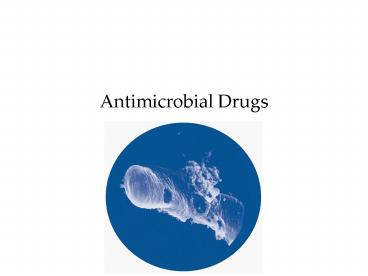Antimicrobial Drugs - PowerPoint PPT Presentation
1 / 21
Title:
Antimicrobial Drugs
Description:
... transposons Resistance to Antibiotics Antimicrobial peptides Broad-spectrum antibiotics Nisin (lactic acid bacteria) Magainin (frogs) Cecropin (moths) ... – PowerPoint PPT presentation
Number of Views:69
Avg rating:3.0/5.0
Title: Antimicrobial Drugs
1
Antimicrobial Drugs
2
How were antimicrobial drugs first discovered?
- Alexander Fleming
- 1928
- S. aureus,
- Penicillium notatum
- Mass production 1940s
- Antibiosis
- Lead to antibiotic
- Different from chemotherapy!
3
Where do antibiotics come from?
- From other bacteria found in
- Soil
- Bacteria
- Streptomyces more than half!
- Bacillus
- Molds
- Penicillium
- Cephalosporium
4
What is an antibiotics spectrum?
- Number/types of organisms it affects
- Narrow spectrum of antibiotic activity
- Penicillin G mostly only gram
- Broad spectrum antibiotic activity
- Tetracycline
- Pros vs cons
- Lead to
superinfections
5
How do antimicrobial drugs work?
- Depends on the drug
- Bactericidal or bacteristatic
- Modes of action include
- Cell wall destruction
- Inhibiting transcription or translation
- Plasma membrane damage
- Inhibiting DNA synthesis
- Inhibiting synthesis of metabolites
6
How can an antibiotic destroy the cell wall?
- Penicillin and others
- Prevent synthesis (crosslinking)
- Cell then lyses due to weakened wall
- Only affects actively growing cells
- Does not affect humans
7
Can you discuss some examples?
- Penicillin
- Penicillin G
- Narrow spectrum, penicillinase susceptible
- Penicillinase-resistant penicillins
- Methicillin
- MRSA
- Replacing methicillin oxacillin, nafcillin
- Extended spectrum penicillins
- Ampicillin, amoxicillin
- Effective against both gram and
- Cephalosporins
- Penicillinase resistant, gram effective
- Vancomycin
- Narrow spectrum
- Last resort
8
How can they inhibit protein synthesis?
- Tetracyclines, chloramphenicol, streptomycin,
etc.
9
How do they injure the PM?
- Polypeptide antibiotics (e.g. polymyxin B)
- Change permeability of PM
10
How do they inhibit DNA synthesis?
- Limited usefulness WHY?
- Quinolones
- Inhibits DNA gyrase
- UTIs
- Fluoroquinolones
- Ciprofloxacin (Cipro)
- Affects cartilage development
- Can be used in adults
11
How do they inhibit synthesis of important
metabolites?
- Competitive inhibition
- Synthetic drug
- Sulfaniamide inhibits para-aminobenzoic acid
(PABA) - PABA is precursor for making folic acid
- Sulfa prevents conversion
- Humans dont make folic acid, we eat it!
- Broad spectrum
12
What are some antifungal drugs?
- Many target fungal sterols
- Ergosterol vs. (humans) cholesterol
- Azoles
- Athletes foot, yeast infection treatment
- Others target chitin cell wall
- Echinocandins
- Many others which we wont worry about
13
What about antiviral drugs?
- Very few WHY????
- Drugs can attack
- Attachment
- Penetration
- Uncoating
- DNA/RNA synthesis
- Virion assembly
14
Can you tell me about a couple?
- Nucleosides and nucleotide analogs
- Acyclovir genital herpes
- Interferons
15
What tests are used to identify antimicrobial
activity?
- Disk-diffusion
- Cant determine bactericidal vs. stasis
- Gradient diffusion
- Broth dilution
- Can determine bactericidal vs. -stasis
16
Effects of Combinations of Drugs
- Synergism occurs when the effect of two drugs
together is greater than the effect of either
alone - Antagonism occurs when the effect of two drugs
together is less than the effect of either alone
17
Whats next?
18
Is there a downside to antimicrobial or
antibiotic use?
- Yes!
- Natural selection
- Antibiotics
- Always take the full prescription
- They dont work on viruses!
19
What types of resistance are there?
- video
- Destruction of the drug (e.g. penicillinase)
- Prevention of drug penetration
- Common with tetracycline
- Alteration of drug target site
- Rapid efflux
- Heredity
- Transformation, transduction, transposons
20
Resistance to Antibiotics
21
Future of Chemotherapeutic Agents
- Antimicrobial peptides
- Broad-spectrum antibiotics
- Nisin (lactic acid bacteria)
- Magainin (frogs)
- Cecropin (moths)
- Antisense agents
- Complementary DNA that binds
- a pathogen's virulence gene(s)
- and prevents transcription
- Fomivirsen to treat CMV retinitis
- siRNA
- Complementary RNA that binds mRNA to inhibit
translation































